Learn how long chameleon lifespans can be in captivity
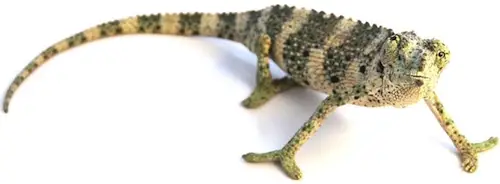
How long chameleons live
Chameleons can live anywhere from two years to 20+ years. Yes, I realize that’s a wide variance, and the reason is that it’s very species-specific. I’ve mentioned before that I’ve witnessed a positive correlation between the size of a chameleon, and its lifespan.
For instance, I’ve found that the shortest chameleon lifespan I’ve witnessed is that of Pygmy chameleons (Rhampholean sp.), which are also the smallest regularly available species. I think this is natural for them, because they reach reproductive age very quickly, and generally only live for 1-2 years. I don’t believe this is husbandry-related.
On the flip side of the coin, let’s look at the biggest species, the Parson’s chameleons (Calumma parsonii). Their lifespans can exceed, based upon anecdotal evidence, 20-25 years. It’s also interesting to note that it can take them years to even become physically ready for reproduction. This also suggests that their lifespans are just naturally longer.
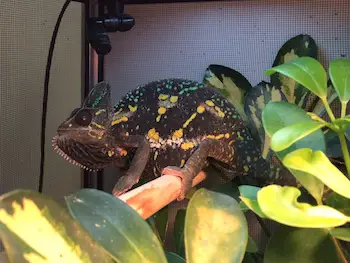
Here’s one of my gravid Veiled chameleons, very
much wishing to be left alone. Notice the dark
coloration and teal spotting. She’s about three
years old in this photograph, with an expected
lifespan of another year or so.
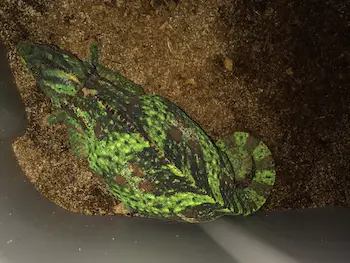
This Veiled chameleon is heavy with eggs—she ended
up laying 72 in all. Reproduction is a major factor
when discussing chameleon lifespans.
We’ve established that chameleon lifespans can very greatly, with much of it dependent upon the species. But there are several other very important factors influencing how long they can live that must be considered.
Males generally live noticeably longer than females. Why you may ask? It’s because reproduction takes its toll upon females. The formation of eggs requires significant amounts of water, calcium, and other minerals. Digging a tunnel and laying the actual eggs is an arduous process if you’ve ever witnessed it.
Now, consider that many chameleons can reproduce multiple times per year and you’ll start to understand how taxing the process can be for females. I guess you could say, males have all the fun.
The above explanation is further amplified if a female becomes gravid before she’s fully matured size-wise. Many species of chameleon can reproduce far before they’re bodies are finished growing. Veiled chameleons, for example, can breed before they’re six months of age, and they can have huge clutch sizes.
So, in these types of scenarios, the juvenile female chameleon’s body must suddenly stop growing to focus entirely on reproduction and egg formation. It’s something that really should be avoided, despite requiring patience. It’s well worth the wait.
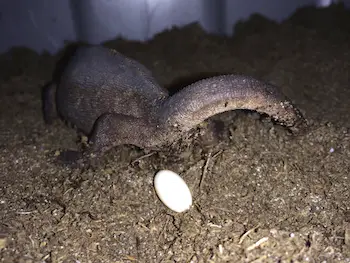
Some chameleon imports arrive “overly” gravid meaning
they need to lay their eggs asap and don’t have time
to dig a hole. So, as necessity dictates, they lay
their eggs right on the surface. This type of stress
can reduce the lifespan of a female chameleon.
Pictured is a female Furcifer pardalis.
While it’s true that keeping multiple chameleons together can work out successfully if the enclosure is large and there are plenty of secluded areas for each chameleon to be alone if need be, I usually recommend keeping just one chameleon per cage. There are a few exceptions such as Pygmy chameleons.
The last factor I’ll mention is water, or a lack thereof. You may think your chameleon is doing great, but are you sure it’s getting enough hydration? Again, I’ll go back to my theory that you should learn from your chameleon through observation, rather than giving it what you think it needs.
Give it a drip, or misting, and if it drinks for 10 minutes, keep giving it water until it stops. If your chameleon laps up the droplets then walks away when they are gone, don’t assume it’s no longer thirsty. Continue giving your chameleon water until it chooses to stop drinking.
Chronic dehydration is an epidemic with captive reptiles, not just chameleons. It can slowly lead to the lizard’s death over months or years due to eventual kidney failure.
The above four factors all have a strong influence upon how long your chameleon will live in captivity. While you can’t control it’s genetics, you can control the above variables.
The last lifespan factor I’ll mention is whether or not the chameleon is captive bred or imported (aka wild caught). While I’m certainly not against importing responsibly-collected chameleons from the wild, they can sometimes end up having shorter lives than captive bred specimens. This is definitely not a rule, just a consideration. Some of my absolute toughest chameleons are imports.
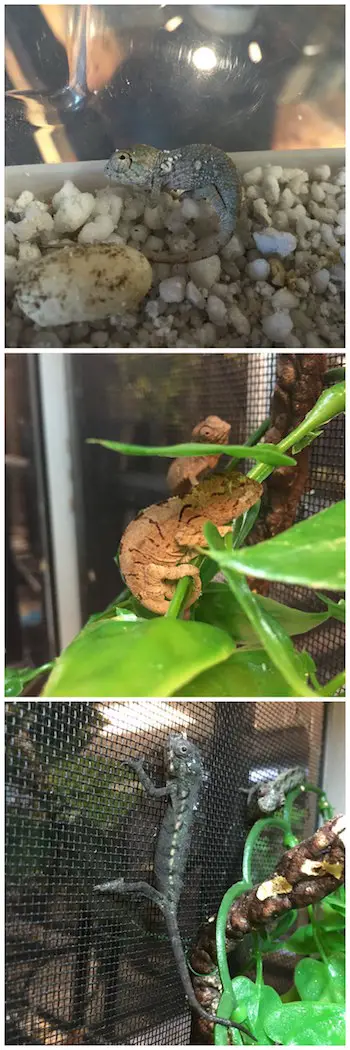
I recently was above to cross a male Panther chameleon to a
female Oustalet’s. The resulting eggs hatched at a 100% rate
and the babies did extremely well and grew like weeds. The
above collage shows the high variability of colors and patterns
amongst the hatchlings. I believe these crosses will have
similarly long lifespans as their parents.
Here I’ll go over the average lifespans I’ve witnessed for specific species in captivity, mainly the more commonly available ones, but a few of the rarer ones too. Some may have experienced numbers outside my ranges, but I can only speak for my own experiences with them.
Jackson’s chameleon (Chameleon jacksoni) - 3 to 5 years. I rarely raise these from babies, but I’ve kept good breeding adults for years.
Veiled chameleon (Chamaeleo calyptratus) - 3 to 6+ years. My oldest is a six year old male I raised from a baby that’s still going strong.
Oustalet’s chameleon (Furcifer oustaleti) - 3 to 7+ years. My oldest is a six year old female I raised from an egg. This suggests to me that males could live even longer.
Panther chameleon (Furcifer pardalis) - 3 to 7+ years. The females can burn-out a little quicker than some other species.
Four-horned chameleon (Trioceros quadricornis) - 3 to 5 years. My imports always seem to do very well, almost better than some of the captive bred specimens I’ve purchased.
Pygmy chameleon (Rhampholean sp.) - 1-2 years. I’d be very impressed if there was evidence of one of these living to three years.
Parson’s chameleon (Calumma parsonii) - 15 to 20+ years. Admittedly I’ve only been keeping this species for a few years, but I do still have an original Yellow-lip female that laid 68 eggs for me. She arrived fully grown and gravid, and that was quite a while ago. It’s said that they can live for 20+ years, and they apparently aren’t even reproductively ready until three years of age.
Carpet chameleon (Furcifer lateralis) - 2 to 4 years. I’ve hatched some out, and the babies are tiny and difficult to raise. Adults can be good breeders, but not an overly long lifespan.
Meller’s chameleon (Chamaeleo melleri) - 5 to 10 years. While captive bred babies are nearly impossible to come across (I’ve had a few), I can say that once established, the adults are strong and long-lived. My estimate is based upon having a fully-grown adult for four years, as well as some anecdotal evidence.
Senegal chameleon (Chamaeleo senegalensis) - 2 to 3 years. Probably 99.9% imports.
Fischer’s chameleon (Kinyongia multituberculata) - 3 to 5 years. Strong and sturdy once established.
Rudis chameleon (Trioceros rudis/sternfeldi) - 3 to 4 years. A smaller species with a similarly short lifespan.
Giant spiny chameleon (Furcifer verrucosus) - 3 to 5 years.
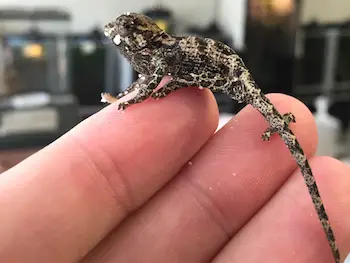
Here’s a baby Johnston’s chameleon I hatched-out. They’re some
of the biggest hatchlings I’ve come across, with very long tails.
The adult coloration is absolutely stunning.
